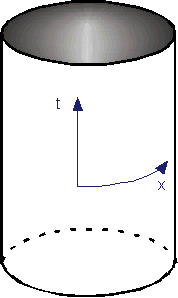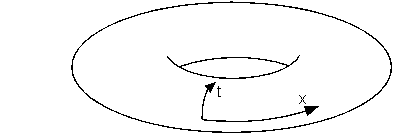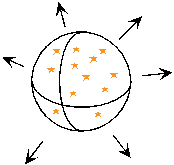
Today:
Next
:Consquences of General Relativity
: Note the profound point of general relativity is that all effects of a uniform gravitational field are identical to the effects of a uniform acceleration of the coordinate system. So consider someone, who we will call Frank, falling from the Sears tower. Frank does not feel his weight. Hence, he does not feel gravity. Frank is in an inertial frame!! In his frame, it looks as if the earth is accelerating towards him and he is stationary. An observer on earth says that gravity is present and causing Frank to fall to the earth. Both stories are equally valid and there is no way to distinguish between them if the distance Frank falls is sufficiently short. What do we mean by this? Consider a thought experiment in which two apples are placed on a table which subsequently falls to the center of the earth. In the apples's frame, no forces are acting on them. Hence, they should fall in a straight line. Since the two apples start out at some distance apart and they fall in a straight line according to Euclid, their paths should not touch. However, they will meet in the center of the earth. So there is a problem. So what gives? It is our Euclidean definition of a straight line. An object falling in a gravitational field follows a geodesic, the shortest distance between two points. Such trajectories are determined by the curvature of spacetime. Hence, it is not a contradiction for geodesics to intersect. For example, all geodesics on a sphere intersect.Oddities: Time Travel
Once we allow curved geometry, we can imagine different topology as well.
The topology of a space is its "connectedness." For example, how many holes does it have (also knots, but I won’t discuss).Consider a cylindrical universe
:
The
local geometry of a cylinder is flat, but one coordinate is cyclic. If our universe had this topology, there would be a preferred reference frame, the one with the time axis along the cylinder, as shown. This is an example of the situation not manifesting the symmetry of the physical laws. We’ll encounter this again later.Would this mean that Galilean relativity is wrong?
To what extent must we regard the geometry of the universe as just another contingent effect?
Consider a donut universe
:

The local geometry is curved. The time coordinate is cyclic.
What does this imply for the usual notions of causality? How can one distinguish past from future here?The simple donut is not a valid, but solutions to the GR equations have been found which allow time travel by ordinary objects (the first was found by Gödel in 1948). They don’t necessarily require weird topology, but they do all seem to require unusual global behavior of spacetime. This issue is unresolved.
Horizons: Black Holes
Near a small, massive object the gravitational potential, -Gm/r, can be large. Suppose that 2Gm/rc2 equals 1. Then the redshift becomes infinite. What does this mean?
It means that light emitted from closer than this, r < 2Gm/c2 cannot escape. An object that behaves like this is called a
black hole, and the critical radius is called the horizon. There is no way we can ever learn what is happening inside the horizon.Black holes are difficult to detect, because they are black. There is quite a bit of indirect evidence for the existence of two varieties of black holes, remnants of supernovas (mass ~5-10 Msun) and supermassive (106 Msun) black holes at galactic centers
(including our own).The important conceptual point here is
the existence of hidden regions of the universe. They have profound implications (not well understood) for determinism and causality. More later.Black Hole Horizon
How acceleration (gravity) can give a horizon:

With a big enough lead (and enough acceleration), the laser pulse will never reach its target.
What do we see if we drop something into a black hole? We do not ever see it crossing the horizon. From our point of view, its clock keeps slowing down indefinitely as it approaches the vanishing point. From its point of view, the trip to the center takes a finite time.
Consider two observers A and B. Key Question: what does observer A see when B crosses the event horizon of a black hole. A sees that B's clock slows down. He then measures that it takes longer and longer for a light signal from B to reach him. B eventually just becomes a blur. A will always measure that B is at the event horizon because relative to A, B's clock has stopped. B, however, sees none of this. She is already inside the black hole. But A will always detect her as never having crossed the event horizon.
Singularities
At the center of a black hole is a singularity, where the geometry becomes poorly behaved (infinite curvature, for example). If you try to draw a geodesic through a singularity, you find that it isn’t uniquely determined.
(Nothing bad happens at the horizon.)Singularities are usually a sign of two things:
The first escape route isn’t open to GR. Black holes seem to be formed in a great variety of circumstances. The second escape route, if it exists, would only be significant at extremely short distances
(due to QM effects – I won’t discuss now).The singularity in a black hole isn’t a problem, because it is hidden. Are there any that are visible?
The interesting point here is that there must be at least one visible singularity in GR. This conclusion upset Einstein so much that he "broke" the theory trying to evade the prediction. The singularity is at the "beginning" or "end" of time. That is, there cannot be a static, unchanging universe.
There must be a "big bang" or a "big crunch" (or both).
The Universe is not Static
This problem is not new to GR. One of Leibniz’ arguments against Newton’s absolute space was:
If there exists an infinite and unchanging Euclidean space and an absolute time independent of the stuff that is in it, then either:
GR extends the problem to spacetime itself. It tells us that
the universe must be expanding or contracting. Gravity can never give rise to a static solution. Einstein put in a fictitious repulsive force by hand to make the universe static. He did this because he reasoned that the universe must be static. We will get back to this later. This means that either there is an earliest time before which we can have no knowledge or a latest time (or both).This is easiest to visualize with our 2-d sphere analogy. The sphere is a balloon which is being blown up.

The universe is expanding
What is observed?
(Hubble, 1932)Distant galaxies are moving away from us. The farther they are, the faster they are receding
(a linear relationship). This means that at some time in the past, they were all right here ... The whole universe was squashed together. This does not violate Galilean relativity. There is no center (preferred location).Suppose I have several friends:

If they have been moving at a constant speed, I can say that 10 seconds ago, each was at my present location. Notice that
A sees exactly the same thing that I do. (Different people, but the same relationships.) The quantity that describes this motion isIn our universe, H ≈ 60 km/s per megaparsec. A galaxy which is 1 megaparsec (~3 million light years) away is receding at 60 km/sec. If one converts megaparsecs to km, one finds that the expansion began ~17 billion years ago.
Note: If my friends are slowing down
But you ask- won't the ones far enough away from you be receding faster than c?
Yes- but in GR the speed-limit becomes LOCAL:
nothing can go right by you faster than c.
Anything receding from you faster than c, while belonging to some mathematical extension of the universe itself, would not be directly observable now. Whether it would be observable in the long run depends on the time dependence of space.
How does GR describe the expansion?
Remember our balloon analogy for curved geometry:
|
|
Think of dots painted on a balloon. As the balloon expands, the dots move apart. |
GR says the balloon must either be expanding or contracting. In fact, it is expanding. The age of the universe may not be the naïve value of 17 billion years, due to acceleration or deceleration. The expansion rate is changing due to the mutual gravitational attraction/repulsion of all the matter in the universe.
Will the expansion ever stop?
If I throw a ball in the air, will it fall down?There are two possibilities. If the attraction is strong enough, and the speed small enough, then the expansion will stop, and the universe will collapse into a big crunch. If not, then it will continue to expand forever.
Right now, it looks as if the expansion will continue for ever, although there are some untested extrapolations.
The connection between density and geometry
For a particular expansion rate, there is a critical density,
r c, above which the geometry is closed and finite. For lower r, the curvature is saddle-like and the universe is open and infinite. We define a dimensionless parameter W ş r/rc to describe the situation.There is a relation between W, the geometry, and the fate of the universe:
|
Density |
Spatial geometry |
Expansion* |
|
W < 1 |
Saddle-like (open), infinite |
continues forever* |
|
W = 1 |
flat, infinite |
continues forever, but rate ®0 asymptotically* |
|
W > 1 |
Sphere-like (closed), finite |
Reverses to collapse in a finite time* |
*This column dates from a few months ago. It assumes that all the density consists of stuff that gets diluted as the universe expands. Anything whose density doesn't change actually pushes the universe apart. It now seems that such a smooth background density DOES exist. More later
There is no edge, but there is a horizon
Even though the universe is expanding, it is not expanding "into" anything.
There is not an edge to the matter, beyond which there is only empty space.There is a GR analog to the edge, however.
There is a horizon, dependent on the observer. The linear relationship between distance and speed tells us that beyond a certain distance (c/H ≈ 17 billion light years) the stuff out there is moving away at faster than light speed. I.e. space is expanding so fast that it is being carried away faster than the speed of light.Doesn’t this violate special relativity?
What's left of the SR speed-limit is the constraint that any LOCAL measurement of a speed give c or less. Inferred speeds of parts of the universe with which communication is impossible are not governed by that constraint.
Does the BB really exist?
Besides the Hubble expansion, the main evidence for the big bang is the
cosmic microwave background. When the universe was much more compressed, it must have been much hotter than now. Hot objects glow. We can see the remnants of this glow in the 2.7K radiation that fills space. When it was emitted the temperature was about 3000 K and the universe was about 300,000 years old. (Of course the universe was even hotter earlier, but we wouldn't be able to see that, since when atoms are heated up above that the electrons fall off. Loose electrons are very good light absorbers/ reflectors, as in metals. So until the universe cooled to about 3000 K, it wasn't transparent. We see back to the point at which it first became nearly transparent.) This radiation was predicted by Gamow, Alpher and Herman in the 1940s and discovered in 1964 by Penzias and Wilson.)
Is there another conspiracy at work?
The reason we don’t know whether the universe will continue to expand is that the observed density of matter in galaxies is close to the critical value (
WM ~0.2, or so). This is actually amazingly close to 1. As we look back in time, WM was closer to 1 than it is now. For example, one year after the "bang," it must have been something like 0.999999999. If we look back to the last time at which some physics that we aren't sure about might have changed WM, the value is EXTREMELY close to 1. Is this an amazing coincidence, or what?It has been proposed
(by Alan Guth) that W (total, possibly including a smooth background not in galaxies)is (almost) exactly 1, based on a model of the big bang known as "inflation," Fundamental theories which predict inflation exist but are very hard to test. We will discuss inflation later, when we can give some hint as to what might cause it.A comment
: If the initial value of WM were much bigger than 1, the universe would have collapsed much too quickly to have ever developed intelligent life. If it were much less than 1, galaxy formation would never have taken place, and (again) we wouldn’t exist.There are many similar parameters which must be fine tuned for life "as we know it" to exist. This has led some people to formulate the "
anthropic principle." Basically, the universe must be about the way it is, because we’re here to observe it. More on this at the end of the course.So, where do we stand, after SR and GR?
Does the Earth go around the Sun?
Let’s revisit this question, for the last time. We concluded that the Earth orbits the Sun (approximately) because otherwise we would have to throw out the whole Newtonian framework that described not only planetary motion, but pendulums, etc. Now we have thrown out that framework anyway, and replaced it with a different (and more generally accurate) one.
What happens in our new framework?
The GR laws are the same for an "accelerated" reference frame
(such as the Earth) as for any other. However, there are still reasons for preferring reference frames that are near to the old "non-accelerated" ones.This is a nice argument, but it
doesn’t carry the same weight as the old Newtonian one, in which non-inertial observers get the wrong laws of physics. We're stuck with GR whichever reference frame we use.
BTW- We know that GR or QM is wrong, if pushed to extremely small length scales. Almost no-one thinks that QM will be wrong in such a way as to allow GR to be right.